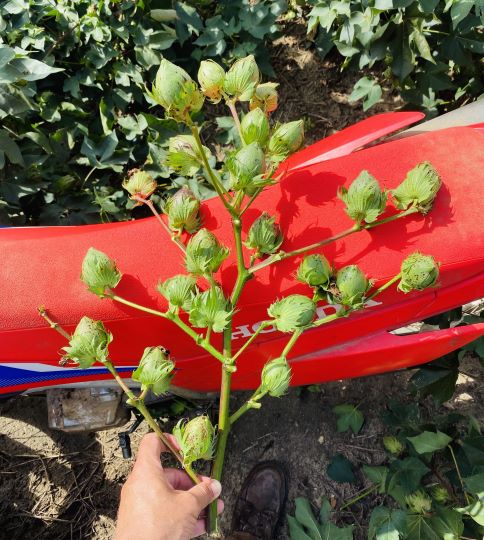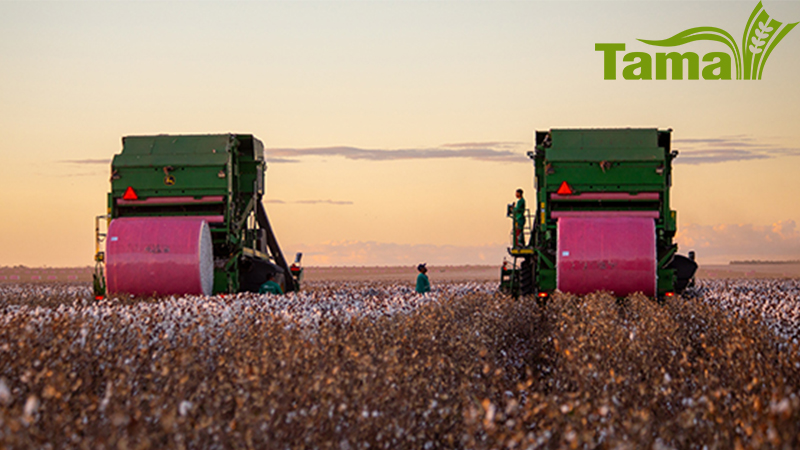Crop Scan Ag Report: Wrapping Up the 2022 Season with Fingers Crossed
Our final Crop Scan report for the season notes that harvest is underway in parts of Texas and the Mid-South and just around the corner for most of the Southeast and Texas High Plains. Rain is simply not needed at this time as growers prepare to bring this crop home. Many thanks once again to our participating Crop Scan consultants for their time and expertise this season. Here’s what they told us in mid-September.
Chad Harrell owns and operates Harrell Agronomic Services in Northeastern North Carolina.
Most of our cotton is about two weeks ahead of schedule this year. We have been hot and extremely dry for the past few weeks, causing cotton to mature fast. We won’t be waiting around on a top crop to defoliate this year since most top bolls have aborted due to dry weather. Although, we still have a nice boll load lower in the plant with no hard lock.
A few growers have begun defoliating the earlier cotton this week, and we should be picking by the end of the month. The later planted cotton should be ready to defoliate in early October.
Growers should keep regrowth in mind while defoliating over the next few weeks as we expect it to be heavy when we get some rain. We don’t have a bumper crop this year due to the dry weather, but I think that we are going to see some solid yields with 2+ bales in most areas.
Wes Briggs consults on cotton, corn, peanuts, soybeans, and small grains for growers in Georgia, Alabama, and Florida.
To date, only a handful of fields have been defoliated in South Georgia. Defoliation will begin this week on our earliest planted cotton, with the majority of cotton still 14-21 days away from defoliation.
Despite rain during the last three weeks, we finally managed 7-8 days of much needed sunshine in the past week. Yields still look promising, however I think we easily lost 20% to hard lock and boll rot. Younger cotton shed a tremendous amount of fruit over the last 2-3 weeks due to cloudy, rainy conditions. Boll retention has been remarkable in early planted cotton this year (see picture below). Currently, on Sept. 18, we are drying out fast and cotton is opening faster.
 Photo: Wes Briggs
Photo: Wes Briggs
Whiteflies have tapered off some in cotton, but we are still addressing stinkbugs and clouded plant bugs.
I’ve been asked a couple of times lately, “Why does early planted cotton look so good this year?”. There are two reasons. First, we were wet last year with a lot of 3+ inch or more rains. This year we have not had the big rains – maybe one big 3+ inch rain. We never had to dump those 3-4-5-inch rains from gauges this year, so we never leached fertilizer like in 2021. And second, we have a root system this year to support a big boll load. Last year, we didn’t. We stayed saturated early, and cotton never developed a big root system.
Decisions going forward will focus on harvest aids and timely defoliation. As always, some of our most important management decisions and evaluations for 2023 crops are made now, including fertility, insect control, disease management, weed control, and varieties for 2023.
If we can escape hurricanes and tropical storms, this cotton crop is still really good – above average, overall.
Tucker Miller is a Mississippi-based independent private consultant for cotton, soybeans, corn, peanuts, rice, and vegetables.
We have started picking on our first cotton. Yields are good, around 1,200 pounds per acre. This cotton had some hard lock and boll rot but is still good.
 Photo: Tucker Miller
Photo: Tucker Miller
About 80% of our cotton received the first shot of defoliant this past week. We will be making our second shot seven days later where needed. Our later cotton will be getting the first shot about a week from now. We will try to take advantage of the hot weather to finish it out.
Overall, I expect yields to be good, staying in that 1,200-pound range. I hope everyone has a good harvest season with blue skies and white cotton.
Mark Nemec is an independent agricultural consultant for cotton, wheat, grain sorghum and corn in the Blacklands and Brazos River Bottom area of Central Texas.
It’s past time to get this season over.
The rainy spell in Central Texas is over. Rainfall for the last several weeks amounted from 2-8 inches. With the extended wet spell, harvest has not been pleasant. We are experiencing a lot of regrowth that doesn’t want to give up. After the hot and dry summer, the cotton didn’t use all the fertilizer we put out, and it’s showing up now. We’ve also seen some seed sprouting in some of the wetter areas.
Of course, yields are off by half of average in most fields. There are a few bright spots that missed most of the rain, and those areas look pretty good if they had good irrigation in season.
Everyone around here is worn out and ready to put this one behind us and get ready for next year. Come on 2023!
Kerry Siders is Texas A&M AgriLife Extension Agent-IPM for Hockley, Cochran, and Lamb Counties.
 Photo: Kerry Siders
Photo: Kerry Siders
Harvest is just around the corner here on the Texas South Plains. We have continued to receive some rain showers since late August which is a relief from the hot, dry summer and did allow us to discontinue irrigation. It has allowed the many thousands of acres of fallow to be planted with a winter cover which will hopefully keep soil tied down until spring.
Unfortunately, some of these rain events contained hail which destroyed some good cotton. The rain has also brought on some regrowth in fields which did not have a sufficient boll load to prevent this. This juvenile regrowth will be difficult and more expensive to deal with when we use a harvest aid to set the plant up for harvest.
I anticipate that we will start applying harvest aids around the fourth week in September. We generally stick with a quart of ethephon for boll opening. On better cotton, I think the plant will respond normally to the defoliants. I would refer you to my last year’s “Cotton Harvest Aid Edition” of the West Plains IPM Update.
I remind producers to pay attention to what the manufacturers recommend as adjuvants with these products, particularly the PPOs (Aim, ETX, Display, Sharpen, and Reviton). One thing on the PPOs – they are safe on grasses. So, we have used them often near wheat drilled in field margins with no concern. However, Reviton is a newer PPO and is an exception in that it will kill grasses.
As it cools down, be aware that some defoliants can be temperature sensitive. We generally plan on a two-shot harvest aid regime. We will use a paraquat product or, if we have regrowth issues, we will use one of the PPOs in that second follow-up application. I remind producers that paraquat is activated by sunlight. If it is applied early in the day, it will generally result in a rapid burn of the plant tissue and result in typical desiccation (sticking of leaves). In an application applied later in the day, the paraquat will move deeper in the plant tissue (local systemic movement). This can result in both desiccation and additional defoliation.
Have a safe harvest.















